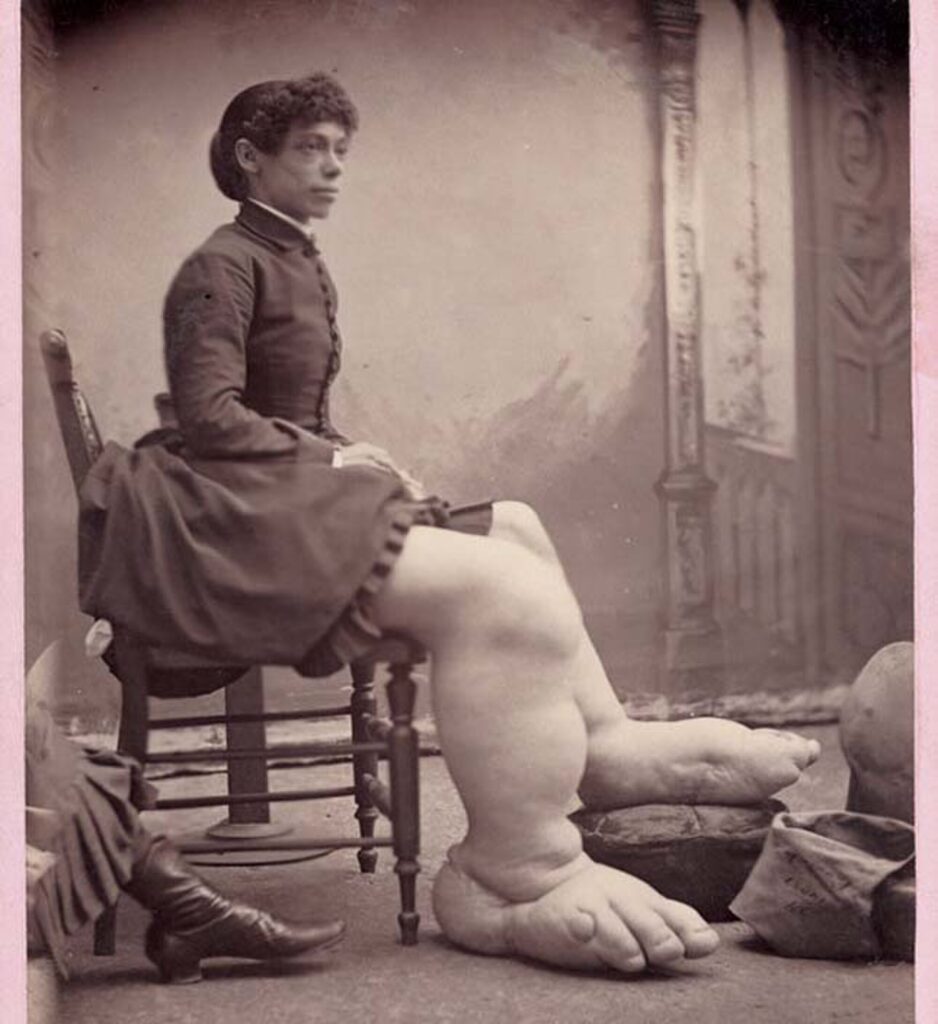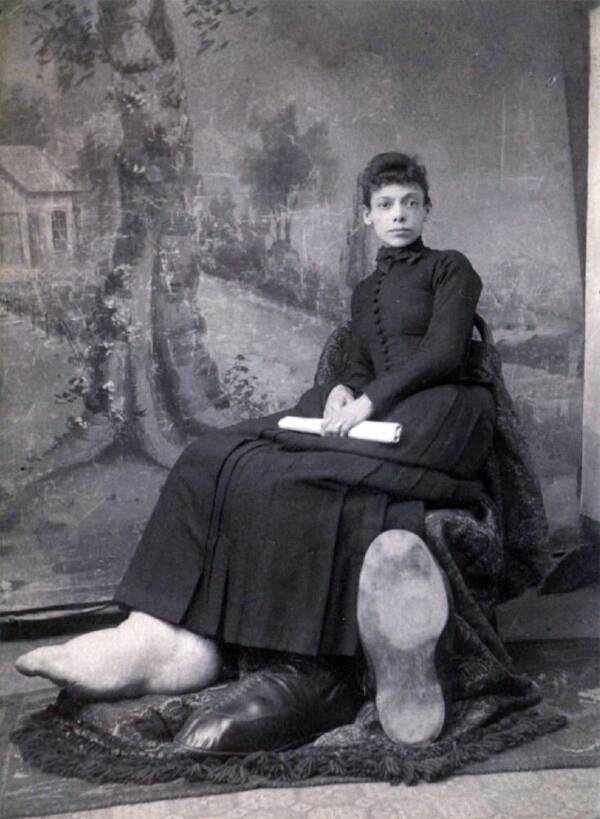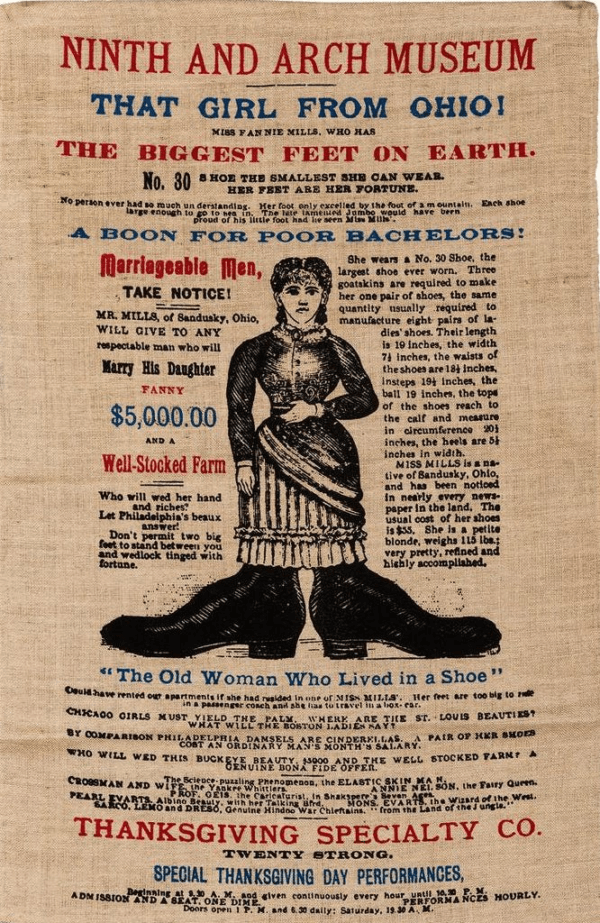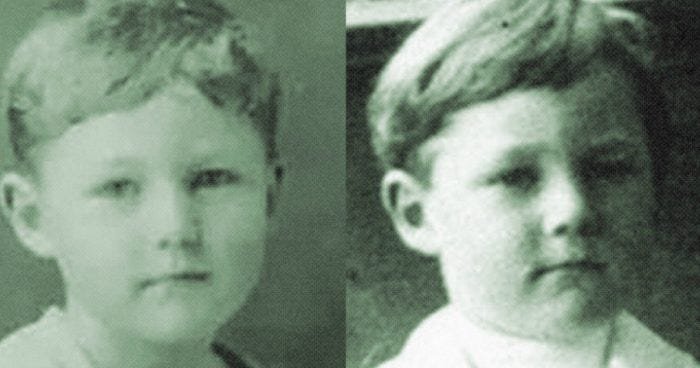Before you get misled by the title of this article, let’s make one thing clear. Fanny Mills wasn’t a girl who had the capability to transform into a female sasquatch.
In this instance, the term big foot applies to a different type of big foot and not a hairy beast you might catch a distant glimpse of if you were hiking through the forests of Ohio.


During her lifetime, Fanny Mills caused a stir wherever she went because she was physically different to everyone else.
In many ways, Fanny Mills’ life, although she’s not as well-known, can be compared to that of the famous Elephant Man, who lived in Victorian England.
While their afflictions had completely different causes, their stories have striking similarities.
Who Was Fanny Mills?
Born in 1860, Fanny Mills was the youngest child of a British family.
The family were originally from a village called Thakeham in the county of Sussex, but emigrated to Sandusky, Ohio, when Fanny was still a child.
There are some notable discrepancies concerning Fanny’s actual age, as a census made in Ohio in 1880 recorded her as being fourteen at the time.
If her date of birth had been registered correctly in England, then she would have been twenty years old and not fourteen as the Ohio census stated.
What Did Fanny Mills Suffer From?
While Fanny was normal at birth, she had begun to show symptoms of swelling and abnormal growth in her lower body from a young age.
The parents of the Elephant Man blamed his deformities on his mother being trampled by an elephant when she was pregnant.
Fanny’s parents believed her deformities were caused by her pregnant mother having contact with a sick horse. It wasn’t the truth in either case.
No diagnosis of her condition was made while Fanny Mills was alive, but it is now known she suffered from something called Milroy’s Disease.
What Is Milroy’s Disease?
Milroy’s Disease is an inherited genetic disorder that causes exaggerated swelling in the lower limbs of the body. Although doctors were unaware of its cause at the time, Milroy’s has been mentioned in medical journals since the mid-1860s.
The disease is named after the first person who wrote about it, a physician from Canada called William Milroy.
The medical name for the swelling caused by Milroy’s Disease is lymphedema. This, in layman’s terms, is an accumulation of fluids which the body’s lymphatic system is unable to drain away in a normal manner.
Lymphedema itself is relatively common and can be caused by numerous things, including parasites, bacterial infections, skin conditions, obesity and blood disorders. This type of lymphedema is called secondary lymphedema.
The type of inherited primary lymphedema caused by Milroy’s Disease that Fanny Mills had is extremely rare. Statistics published by the National Library of Medicine state that only two-hundred cases have ever been diagnosed.
For Fanny to have inherited the faulty gene that caused her condition, one of her parents must also have had the same defective gene.
As Milroy’s occurs more often in women than in men, it’s possible that Fanny’s mother also suffered with some degree of lymphedema, but there are no historical medical records to substantiate that.
How Big Were Fanny Mills’ Feet?
It’s hard to imagine the enormous size that Fanny Mills’ feet reached by the time she was in her late twenties. Her shoe size was literally off the scale. Fanny took a size 30 US.

There is no comparable UK or European shoe size for mass-produced footwear that big.
Fanny’s feet were larger even than today’s world record holders for big feet. The Guinness Book of Records world record holder for having the largest feet of a living male, a basketball player from Venezuela, takes a size 26 US.
The female record holder, American Tanya Herbert, takes an 18 US, which is around half the size Fanny needed. Neither of the current record holders suffer from Milroy’s Disease, they’re just very tall people with big feet.
Fanny Mills’ footwear had to be specially made for her. It was a monumental task as her feet measured 48 cm long by 18 cm wide. The cobbler who made them had to use the leather from three goat’s skin to ensure they would be a reasonable fit.
While Fanny was fortunate in that long, wide skirts that covered her swollen legs were the fashion of the day, she had to improvise with other items of clothing like socks and would use pillowcases instead.
Why Was Fanny Mills Called The Ohio Big Foot Girl?
Most of Fanny’s life was spent in a home environment. Although she attracted a lot of attention in her home town of Sandusky, her protective father kept both the press and freak show organisers well away from her.
In 1885, When Fanny was twenty-five, her father passed away, and she made the decision to take control of her own life.
Fanny left home accompanied by a friend and travelled five-hundred miles across the country to New York. Once she arrived in New York, Fanny took employment in the Bowery Museum as an attraction.
It should be noted that museums in the late 1880s were different from museums today. They were more like theatres and hosted freak shows, illusionists and anything else out of the ordinary that would draw in the curious working-class crowds.
Fanny Mills, The Ohio Big Foot Girl
During her act, Fanny would sit on a chair and raise her skirts to expose her gigantic legs and feet.

What made her lower limbs look even larger than what they were was her otherwise diminutive stature. As a mature adult, Fanny only weighed about fifty kilos.
It was while she was working at the Bowery Museum that the New York Times newspaper began publishing articles about the girl from Ohio with the biggest feet in the world.
The museum also ran promotional campaigns focusing on Fanny and her big feet, including one that offered a large dowry to anyone who was prepared to marry her.
Whether Fanny was happy to be the centre of attention for the museum’s publicity is unknown.
At the time of the marriage campaign, Fanny was no longer single but had married the brother of her travelling companion.
Fanny Mills and her big feet were a successful attraction for the museum, and her reported weekly earnings were substantial.
Not only did Fanny work as an exhibit in New York, but she also toured the rest of the country and went on trips with travelling circuses and freak shows to Europe.
Fanny’s fame was short-lived though, as her lymphedema worsened, and she was forced to retire from public life. She and her husband, George Mills, travelled back to Ohio in the early 1890s and set up a home in Perkins, Erie County.
It was while there that Fanny developed one of the more common complications of lymphedema and that was abscesses.
As the suppurating sores became more and more infected, they turned to a lethal form of blood poisoning known as sepsis. Fanny Mills died in 1899 at the age of thirty-nine.
Sources
https://sanduskyhistory.blogspot.com/2021/06/did-fannie-mills-really-live-in-erie.html
https://en.wikipedia.org/wiki/Fanny_Mills
https://www.ncbi.nlm.nih.gov/pmc/articles/PMC5586794/
https://lostmuseum.cuny.edu/archive/exhibit/bowery/
https://ny.curbed.com/2017/10/4/16413696/bowery-nyc-history-lower-east-side













Leave a comment